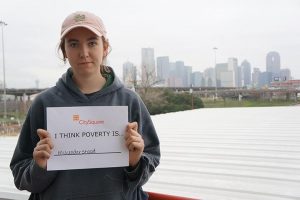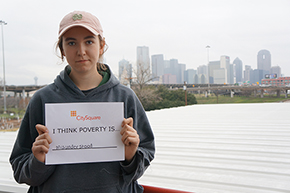Students simulate homelessness in Dallas

To most students, spring break features sleeping in, relaxation and vacations. But for a select group of Hockaday students, their spring break took a different turn. They slept on the streets.
This group of girls slept outdoors and trekked miles under the sun—but this wasn’t a camping trip. Rather, these Hockaday students were simulating what it would be like to be homeless, living on the streets in poverty.
From March 11 to 13, five students—juniors Rajya Atluri, Noor Adatia and Claire Noble and sophomores Wendy Ho and Abby Fuller—accompanied Director of Service Learning Laura Day on the poverty simulation.
The trip was put on through Citysquare, a nonprofit group, which is “fighting poverty in the heart of Dallas.”
In the trip, the girls were simulating what it would be like to live at the current poverty line, which is equivalent to having a salary of $10,000 a year, or $30 a day.
The group first met at Hockaday but soon entered an unfamiliar world. Leaving by bus from Hoak Portico, they were deposited south of Deep Ellum on I-30, “where there’s a giant homeless population,” Day said.
In order to accurately simulate poverty, every member of the group was given real and “fake” money. The “fake” money was used for various activities, and each person in the group received $7 to cover all of their meals during the 45-hour trip.

For the group, the limited money for meals posed the first critical challenge.
“There’s no grocery store nearby since [the area was] a food desert, so you basically either have to go to restaurants, which are so expensive, or convenience stores like 7-Eleven where they jack up all the prices since there’s no competition nearby,” Atluri said. “That’s not super healthy since it’s junk food,” Atluri said.
To combat this issue, the group went to 7-Eleven but pooled its money together to buy bread, peanut butter, and bananas for their first dinner.
During the first night of the simulation, the participants slept outdoors near a highway, but experienced many difficulties caused by cold weather, noise pollution, bright lights and water sprinkler systems. While the group was alone in the elements with no “security” or physical protection, the program was still considered to be completely safe.
“There’s a pretty [well-known] organization that’s in charge of it so they’re careful about liability. There were no safety concerns,” Day said.
On the second day, the “fake” money was used for different activities around Dallas. “This is the part I can’t really discuss, but you had to have money for various activities,” Day said. Day plans to keep these activities secret so next year’s participants do not gain an unfair advantage.
In addition to these activities, the participants went on a scavenger hunt of sorts to find places and experience situations that homeless people face daily, like finding out where to get affordable health care, job services and transportation. To accomplish this, they took public transportation and trekked around downtown Dallas.
Later that day, the group was able to visit Austin Street Shelter, where they received a tour and were informed about all the programs that the center runs for the impoverished.
“That was really eye opening because I never realized how much Austin Street did, because I was involved with bingo and [other activities] but I never saw all sides of it,” Atluri said.
At the end of the second day and continuing into the next morning, the participants had a “reflection experience” where they journaled and discussed their experiences of being homeless.
“I think there’s a misconception sometime that homeless people are just lazy and that’s why they’re homeless. But being part of this experience made me realize how difficult it is and how much work it actually is. Sometimes we’d have to walk several miles and spend all day just trying to get a meal,” Atluri said.
Atluri also noted the mental, in addition to the physical, exhaustion that resulted from simulating poverty.
“I was exhausted every single day. I was so tired, and sometimes in my normal life, I don’t realize how exhausting it is to live the life of somebody else and literally it takes a toll on your body and on your mind,” she said. “It’s also so mentally exhausting because you’re thinking constantly about money.”
Day said that this experience was one of the most enlightening things she had ever done and that in such a short amount of time the gropu was able to gain a very quick window of understanding.
For Day, the most valuable part of the trip was that although it was short, its effects were long lasting and will continue to affect Hockaday girls as future leaders.
“I [was] excited for Hockaday girls because they got to see all the problems and issues of what’s happening, so as future leaders, [this was a] cool way to think about how to solve those problems. There’s a lot of ways to solve this [problem], but you can’t solve a problem until you’re in it,” Day said. “You can see how hard it must be, but if you don’t feel it, there’s no drive or understanding, and that’s what I think was the most valuable part.”
-Sunila Steephen


